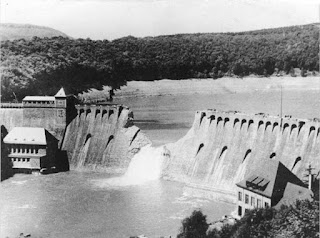80 Year ago Tonight, on the 16th of May 1943, one of the most famous events of World War II occurred.
80 Year ago Tonight, on the 16th of May 1943, one of the most famous events of World War II occurred.
The famous ‘Dam Busters’ raid by the 617 Squadron of Lancaster bombers led by Wing Commander Guy Gibson, breached the Mohne, Eder and Sorpe dams in Germany using the ‘bouncing’ bombs developed by Dr Barnes Wallis.
Take off was 9.28pm on the 16th of May.
On the 17th of May - the following day the devastation in Germany made plain to a shocked country.
It was a huge apparent success for Gibson, Wallis and all those who were part of operation - codenamed, Operation Chastise.
But the cost was high in terms of lives, bomber planes and skilled crewmen.
The Dambuster Pilots practiced their techniques at the Derwent Dam in Derbyshire, England.
Regular practices also took place at Eyebrook Reservoir in Leicestershire, as well as Reculver on the North Kent Coast.
Of the 133 aircrew that took part, 53 men were killed and three became prisoners of war.
On the ground, almost 1,300 people were killed in the resulting flooding.
Although the impact on industrial production was limited, the raid gave a significant morale boost to the people of Britain.
The Eder was Europe’s largest dam, and massive damage and loss of life were caused by flood water, as well as a serious loss of hydroelectric power for the German industrial area of the Rhine.
The dams were fiercely protected. Torpedo nets in the water stopped underwater attacks and anti-aircraft guns defended them against enemy bombers.
But 617 Squadron had a secret weapon: the 'bouncing bomb'.
The Möhne dam in Germany's Ruhr valley secured the water supply for much of the surrounding area. Water from its reservoir was also used to generate electricity. It was thought that destruction of this dam and others in the region would cause massive disruption to German war production. Plans for an attack on the dams had first been considered in 1937, but it took until 1942 to develop a weapon capable of destroying the dams - and the aircraft to deliver it.
In 1942 British engineer Barnes Wallis began working on plans for a bomb that could skip across water. He developed the idea by experimenting with bouncing marbles across a water tub in his back garden. Wallis thought the new weapon could be used to attack moored battleships, but research soon focused on using it against the dams that were vital to German industry.
The Admiralty and the RAF carried out extensive tests at sites around the country. These revealed that the drum-shaped bomb (codenamed 'Upkeep') needed to be dropped from a height of 60 feet (18m), and at a ground speed of 232mph. The bomb would spin backwards across the surface of the water before reaching the dam. Its residual spin would then drive the bomb down the wall of the dam before exploding at its base. All that was needed now was men to fly specially modified Lancaster bombers which would carry the 'Upkeep'.
From 9.28pm on the 16th of May, 133 aircrew in 19 Lancasters took off in three waves to bomb the dams. Gibson was flying in the first wave and his aircraft was first to attack the Möhne (pictured here) at 12.28am, but five aircraft had to drop their bombs before it was breached. The remaining aircraft still to drop their bombs then attacked the Eder, which finally collapsed at 1.52am. Meanwhile, aircraft from the two other waves bombed the Sorpe but it remained intact.
The surviving aircrew of 617 Squadron were lauded as heroes, and Guy Gibson was awarded the Victoria Cross for his actions during the raid. The raid also established 617 Squadron as a specialist precision bombing unit, experimenting with new bomb sights, target marking techniques and colossal new 'earthquake' bombs developed by Barnes Wallis.




















Comments
Post a Comment